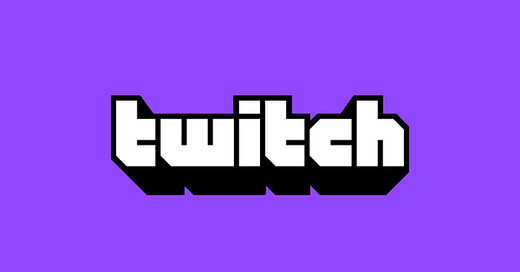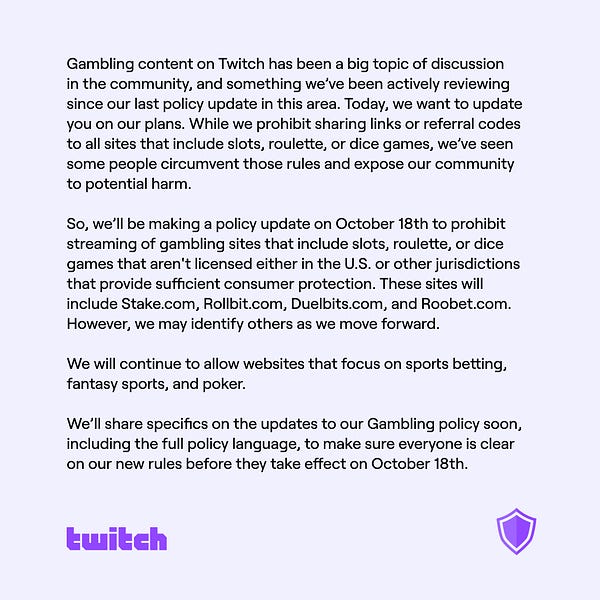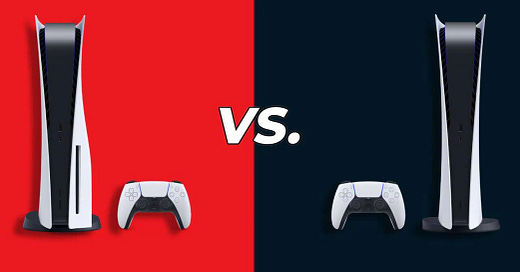
Twitch just became less lucrative for the service's biggest streamers
A new revenue share split means the biggest Twitch streamers could see their overall income fall
➡️ The Shortcut Skinny
🤑 Twitch is changing the way it pays some of its biggest streamers
💵 Those who were on a 70/30 revenue split for subscriptions will now only get 50% after June 1, 2023
🤏 The move will only affect a small percentage of users, and Twitch believes it ultimately won’t affect their bottom line
🎲 Twitch has recently moved to ban the majority of gambling from the platform after a recent controversy
Twitch, the Amazon-owned streaming platform, is reducing how much it pays its biggest streamers on the platform.
The majority of partnered streamers receive a 50/50 revenue share for any subscriptions gained on their channel. 50% of the revenue goes to Twitch, and 50% goes to the streamer.
Some of the service’s biggest streamers, however, negotiated a more favorable 70/30 revenue split with Twitch for subscriptions, where the streamer would get a 70% cut and Twitch would take 30%.
However, moving forward, streamers who currently enjoy the 70/30 revenue share will only receive 70% on the first $100,00 earned. After that, the share will return to the standard rate of 50/50. Twitch stopped offering this premium rate to eligible streamers over a year ago.
The change comes into effect on June 1, 2023, or when a streamer’s contract is up for renewal.
In a blog post on Twitch’s website, Twitch president Dan Clancy said:
“For approximately 90% of streamers on standard agreements with premium subscription terms, this change will not affect them at their current revenue. For those who are affected, we wanted to make sure the impact was minimal — not just by giving them ample time before the deal goes into effect — but also by offering an alternative way to earn revenue.”
Clancy also highlighted that the company recently bumped its ads revenue share to 55% as part of its Ads Incentive Program, which he said is “a great way for these larger streamers to make up most, if not all, of that [lost] revenue.”
According to Clancy, more than 22,000 Twitch users have asked to move all streamers to a 70/30 split and to pay streamers faster. Clancy said that the same viewer hour now earns streamers “three times more money than it did five years ago, on average” and that the company’s investments into more monetization options has “put more money into streamers’ pockets than 20% more subs revenue share would have.”
Clancy also touched on the cost of running a service like Twitch. In the blog post, Clancy explained:
“Delivering high definition, low latency, always available live video to nearly every corner of the world is expensive… We don’t typically talk about this because, frankly, you shouldn’t have to think about it. We’d rather you focus on doing what you do best. But to fully answer the question of “why not 70/30,” ignoring the high cost of delivering the Twitch service would have meant giving you an incomplete answer.”
Last year, Twitch announced that partnered streamers could stream to rival platforms such as YouTube and Facebook Gaming, after previously locking users to its service under an exclusivity agreement.
An email seen by The Verge said, “When we first developed the Partner Program, we felt it was important for streamers to focus solely on Twitch for live streaming to build their communities. We still believe that Twitch is the best place for creators to build and engage with their community. We also recognize that the digital landscape has changed since we first introduced the Partner Program and that many of you engage with your communities in many different places.”
Unfortunately for Twitch, the company has recently faced a backlash over streamers sending users to gambling sites. In a statement posted to Twitter, Twitch has now announced a partial gambling ban, targeting slots, roulette and dice games. However, poker, sports betting, and fantasy sports like fantasy football remain unaffected.
If you’ve ever fancied getting into Twitch streaming and have dreams of earning the big bucks, it’s worth remembering that only the top 0.01% of streamers are making “quit your job” money. A data breach last year revealed that to make more than the median US household income in 2020 of $67,521, you’d have to be in Twitch’s top 1,322 streamers — or the top 0.015% of all streamers. Most streamers go live for up to 2 to 12 hours a day, five days a week. Still tempted?















Yep, I spent nine months as a mod for a daily streamer, and while it can be exhilarating, the grind to gain a following can take a heavy toll on everyone ... well-being, finances, time.
But if you love it or have a natural mic presence, and can afford to stream daily, do it.